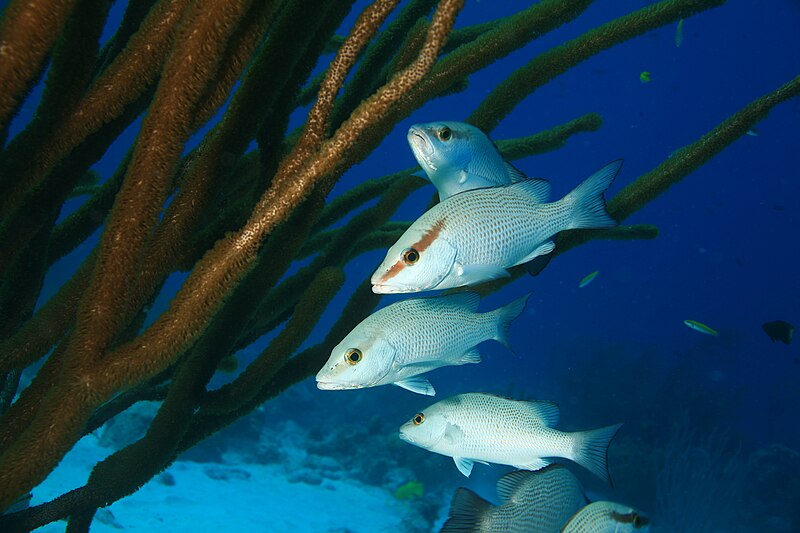
Gray snappers in Santa Cruz Beach. Photo by Laszlo Ilyes, Wikimedia Commons.
Coral reef fish –like the fish in other marine and freshwater ecosystems – are likely to reach smaller maximum sizes and start reproducing earlier with smaller and fewer eggs as climate change continues to warm up the ocean.
In a recent paper in the journal Fishes, researchers at the University of British Columbia’s Sea Around Us initiative gathered additional evidence supporting the idea that fish become sexually active – and spawn for the first time – in response to growth-induced respiratory stress, which intensifies in warmer, low-oxygen environments.
By assembling and analyzing data on the mean length at maturity and the maximum length reached by 131 species of coral reef fish belonging to 207 populations, the researchers estimated the ratio of the gill surface area – and hence oxygen consumption of each species at these two sizes. Such a ratio affects the rate at which fish’s proteins – essential components of their cells and tissues – are naturally degraded or ‘denatured’ and require to be resynthesized so that the organism remains alive.
“As fish grow, replacing denatured proteins becomes more challenging, in part because their two-dimensional gills have difficulties providing oxygen to their growing tri-dimensional bodies. Less oxygen means that there is a point at which the oxygen required for growth and for the re-synthesis of denatured proteins become very tight, which ‘tells’ fish that it is time to spawn,” said Dr. Daniel Pauly, co-author of the study and principal investigator of the Sea Around Us. “When you divide the metabolic rate at first maturity of coral reef fish by their metabolic rate when they have reached their maximum size – which corresponds to their maintenance metabolism – you get an estimate of a threshold value of 1.35 which triggers their maturation and spawning.”
This estimate of 1.35 for coral reef fishes is the same as previously estimated for 106 Chinese and 79 Turkish marine and freshwater fish species, belonging to 116 and 120 populations respectively, and a dozen independent estimates for other, smaller species groups.
“Knowing this ratio is crucial because warmer waters from climate change, being less oxygenated, accelerate the protein denaturation process in fish,” study co-author Elaine Chu said. “This means that, in order to balance out protein denaturation and synthesis and survive, they will need to reproduce at an earlier stage than under normal circumstances. For some species, this may affect their fitness and, therefore, the survival of their population.”
The researchers note that although previous studies have shown that reef-associated fish have evolved a relatively high tolerance to low-oxygen environments, likely because coral reefs go through daily cycles of oxygen levels, in a context where the pace of climate change continues to accelerate, their findings should be carefully considered by conservationists, aquaculturists and fisheries managers.
The paper “The relationship between mean length at maturity and maximum length in coral reef fish” was published in Fishes, doi: https://doi.org/10.3390/fishes9040130

